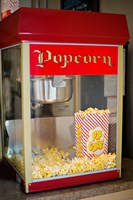Prairie Fare: When popcorn hits the floor — The 5-second rule revisited
(Click an image below to view a high-resolution image that can be downloaded)
Will she or won’t she? I thought to myself.
I continued assembling my flute and arranging my music on a stand for our concert. The aroma and sound of popcorn filled the room.
As the concert attendees enjoyed their boxes of the fluffy white kernels, I noted a person at a table near me dropped several kernels on the floor, not too far from my feet.
She scooped them up and placed them on the table.
Will she eat the popcorn from the floor or not? She continued to eat from the box.
After our first musical piece, I glanced up. The stray popcorn kernels were gone. The empty box was on its side.
When you write a weekly food column, inspiration can happen at any time or place. Many people are firm believers in the 5-second rule.
Is it safe to eat food retrieved from the floor? Researchers have debunked this “rule” scientifically, but people still say “5-second rule!” to justify popping it in their mouths.
Sticky, wet food (such as melon and deli meat) picks up more potential germs than hard candy, according to studies.
Since the popcorn was popped in oil, I think it would pick up more pesky germs than the unpopped kernels themselves.
Technically, as soon as food hits the floor, it is contaminated. You can’t see “germs” on a floor.
Think about it: the soles of shoes that walked across the floor could transmit all sorts of things. Were those feet walking in a dog park or on a golf course filled with meandering geese?
Fortunately, most people will not get sick from a chance encounter with food retrieved from the floor. However, they could. Some bacteria, such as E. coli, can sicken you with a small number of cells.
I tried to focus on my music, but I could still smell the popcorn.
Popcorn is a whole-grain snack. We in the world of nutrition encourage people to make at least half of our grain food choices whole-grain choices. Whole grains contain all parts of the kernel, including the hull (the outer coat or pericarp), endosperm (the starchy part) and germ (the nutrient-dense part that could sprout a plant).
Oatmeal, brown rice, whole-grain breads and cereals are examples of whole-grain foods.
Naturally gluten-free popcorn has been enjoyed for thousands of years, dating back to Aztec ceremonies, according to some historians.
The four types of corn are sweet corn (corn on or off the cob), flint corn (often multicolored and used for decoration), dent corn (used for animal feed) and popcorn.
Technically, popcorn is a type of flint corn. Its moisture and starch content allow it to burst its outer hull upon heating.
Many people enjoy popcorn as a snack, but years ago, it was eaten as a breakfast food served with milk. On average, someone munches about 43 quarts of popped corn annually.
Early movie theater managers were not in favor of popcorn because of the potential mess. Vendors set up outside the theaters and sold the fluffy snack (and made money). Later, popcorn became a moneymaker for the theaters.
If you add a lot of butter and salt, your whole-grain snack is not quite as healthy. Try adding some low-calorie, flavorful toppings, such as smoked paprika or Italian herbs, with a sprinkle of Parmesan.
If you like popcorn with a little extra flavor, try this fall-inspired recipe. It’s low in sodium and fat, yet it satisfies a sweet tooth. This recipe is courtesy of the Popcorn Board (www.popcorn.org).
To keep the calories in check, place a portion in a bowl, and be careful not to drop kernels on the floor. The 5-second rule does not apply.
Cinnamon-Spice Berry Popcorn
6 cups air-popped popcorn*
3 tablespoons brown sugar
3 tablespoons light corn syrup
1 1/2 teaspoon cinnamon
1/4 teaspoon ginger
1/4 teaspoon nutmeg
1/8 teaspoon cloves
1 1/2 tablespoons butter
1/2 cup dried cranberries
Combine brown sugar, corn syrup, spices and butter in a microwave-safe bowl; cook on high heat for 2 1/2 minutes until bubbly hot. Add dried cranberries to popcorn; toss with hot sugar mixture until well coated. Cool mixture before serving or store in an airtight container.
*You can substitute oil-popped popcorn, but it will increase the fat and calories.
Makes four servings. Each serving has 130 calories, 1 gram (g) fat, 1 g protein, 30 g carbohydrate and 35 milligrams sodium.
(Julie Garden-Robinson, Ph.D., R.D., L.R.D., is a North Dakota State University Extension food and nutrition specialist and professor in the Department of Health, Nutrition and Exercise Sciences.)
NDSU Agriculture Communication – Nov. 20, 2025
Source: Julie Garden-Robinson, 701-231-7187, julie.garden-robinson@ndsu.edu
Editor: Dominic Erickson, 701-231-5546, dominic.erickson@ndsu.edu




